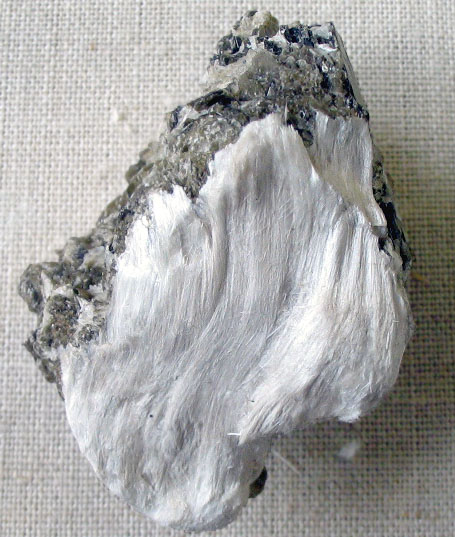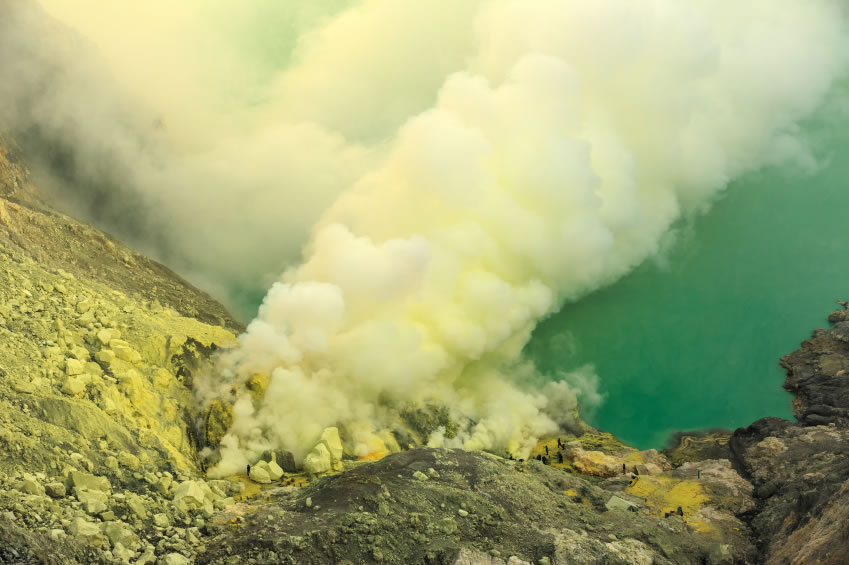Minerals
Minerals are solid substances that have formed naturally in the Earth. They have a characteristic chemical and physical properties and usually a regular crystal structure.
Most rocks that we see today are made of minerals (they are the 'ingredients' in rocks) and both precious metals and gems are subsets of minerals.
There are over 3,000 known minerals. Some of the most common ones and their uses are:
 Asbestos [image left] has an unsavory reputation for causing cancer in people who work around it. It is a fibrous mineral with incredible fire retarding properties. Although asbestos has a bad reputation, when polished it becomes the well known and popular ‘Tiger Eye’ stone.
Asbestos [image left] has an unsavory reputation for causing cancer in people who work around it. It is a fibrous mineral with incredible fire retarding properties. Although asbestos has a bad reputation, when polished it becomes the well known and popular ‘Tiger Eye’ stone.
Barium is a common element used in x-ray technology, fireworks, rubber and glass making and rat poison. It is a soft, white metallic element and alkaline.
Bauxite is a sedimentary rock that is an important ore of aluminum. The aluminum content in it is leeched from the soil above.
Cobalt is famous for the incredible blue color it imparts to glass and pigment. It has been found in meteorites and is used in invisible ink. It is a brittle metal and resembles iron.
Fluorite (fluorspar) is commonly used to create fluorescent pigment and since it is very beautiful, it is used for gem material. It is mined all over the world.
Gold is the most familiar metal to most people. It is used for jewelry, dentistry, electronics and a host of other applications. It is the most malleable metal which increases the way it can be used.
Halite [image right] (sodium chloride--salt) is used for seasoning food and softening water. It is also used to make certain acids, in fire extinguishers and melting ice on the road.
Iron Ore is perhaps as important to civilization today as gold historically has been. It is used in all sorts of construction from vehicles to buildings.
Lead has a bad reputation for its poisoning capabilities, some of which may have been exaggerated by fear. It cannot be absorbed by the skin or breathing, but it is harmful if it touches food or drink. It was at one time used in paint, pencils and eating utensils.
Lithium is used in several applications including medication for bipolar symptoms and batteries. Lithium has become very popular with the advent of electric cars.
Manganese with iron impurities can be slightly magnetic. It is essential in the steel making process, and petroglyphs were carved into it in the Southwest.
Mica is the mineral responsible for putting a sparkle on many rocks. This mineral is very flexible, and large sheets of it were used as window glass in the past.
Nickel is a common metal in everyday life. It has been used in currency, jewelry and eating utensils and is used in alloys as well.
Potash is the old fashioned term for Potassium. Potassium is a major component in crop fertilizer around the world. It is very important in the human body since it works with salt regulating the pressure inside and outside the body’s cell walls. It is also used in soap manufacture.
Pyrite is commonly known as ‘fools gold.’ It is frequently seen in granite rocks where it adds sparkle. Native Americans polished it to use as a mirror, and it is occasionally used in jewelry. Its byproduct is used in ink and disinfectants.
 Quartz [image left] (silica) is the most abundant mineral on earth. It is the name for a large family of rocks including the jaspers, agates, onyxes and flints. Quartz is used in concrete, glass, scientific instruments and watches. Most importantly today, it is used to make silicon semiconductors.
Quartz [image left] (silica) is the most abundant mineral on earth. It is the name for a large family of rocks including the jaspers, agates, onyxes and flints. Quartz is used in concrete, glass, scientific instruments and watches. Most importantly today, it is used to make silicon semiconductors.
Silica is used in desiccants to remove moisture from the air. It is also used in sandpaper and glass making.
Rare Earth Elements (lanthanum, cerium, praseodymium, neodymium, promethium, samarium, europium, gadolinium, terbium, dysprosium, holmium, erbium, thulium ytterbium and lutetium) Many of these are used to create nuclear power.
Silver is one of the precious metals. It is used as currency and in jewelry making. It is also used in medicine due to its anti microbial properties.
Sodium Carbonate (soda ash or trona) is used to control the pH of products. It is used to make glass, paper, detergents and for softening.
Sulfur [image right] is one of the only minerals to be found in its pure form in nature. It is a major ingredient in acid rain but it also is used in wine making and fruit preservation.
Tantalum is used when an alloy needs a high melting point and strength. It is used in missiles, aircraft parts and vacuums.
Titanium is one of the most abundant and toughest metals on Earth. It is used extensively in human body repair.
Tungsten is a metal that is stronger than steel and a high melting temperature. It is also used to make saw blades and used in welding.
Uranium is a highly radioactive element. It is used in cancer treatments, X-rays, military weapons and fuel for the space shuttle.
Vanadium is found in many foods and helps bones grow. It is useful in regulating blood sugar in diabetics and helps grow muscles for bodybuilders.
Zeolite is known as the ‘stone that dances’. It is used in wastewater cleanup and since it can absorb ammonia, it is used in kitty litter and reducing other animal smells.
 Zinc [image left] is essential for a healthy life. Zinc deficiency can cause rashes, diarrhea, impaired taste and eye problems. It is used to macular degeneration, diabetes and the common cold.
Zinc [image left] is essential for a healthy life. Zinc deficiency can cause rashes, diarrhea, impaired taste and eye problems. It is used to macular degeneration, diabetes and the common cold.
Some examples of minerals mined here in Ireland are:
Gypsum
Gypsum is an evaporite mineral and the most common Sulphate mineral in the world. It is used widely in the construction industry in the form of plasterboard and wet plaster. Gypsum
Gypsum is a very soft mineral with a variety
of uses, most commonly in drywall, also known as sheet rock. It is also
used as a fertilizer and road construction. It is mined in areas of Co. Cavan.
Copper
Copper is a soft, malleable, and ductile metal with very high thermal and electrical conductivity. It is widely used in electronics industry especially for use in wires.
Copper is a common metal throughout the
world. It is used for currency, jewelry, plumbing and to conduct
electricity. It is a soft, orange-red metal. Copper has previously been mined in Co. Wicklow.
Lead and Zinc
Lead and Zinc, and sometimes silver, are usually found occurring together. Ireland has a long histroy of minig lead and zinc with some of the larges mine Europe recently operating here; Lisheen Mine (Co. Tipperary) and Tara Mine (Co. Meath) and historically Silvermines (Co. Tipperary).
Precious metals
Precious metals are rare, naturally occurring metallic chemical elements of high economic value. Chemically, they tend to be less reactive than most elements. They are usually ductile and have a high lustre. In history precious metals were important as currency but are now regarded mainly as investment and industrial commodities.
The main examples of precious metals are Gold, Silver and Platinum.
Some examples of precious metals found in Ireland are;
1. Gold
Gold is a valuable, yellow metal. Gold is usually found in metamorphic rock. It is found in underground veins of rock where the inside of the Earth heats the water that flows through the rock.
Gold has been important all throughout history, it was used in important events by the ancient Egyptians and was important in Bronze Age Ireland. Due to both it beauty and its durability it is regularly used in jewellery and as a form of currency.
Trace amounts of gold are found almost everywhere, but large deposits are found in only a few locations.
In Ireland gold has been found on the slopes of Croagh Patrick but it has not been mined primarily because of the mountain’s religious importance. Ireland’s first gold mine is now open near Omagh in Co. Tyrone.
2. Platinum
Platinum is a valuable grey-white metal. It is one of the rarest elements in the earth’s crust. It is dense, malleable, ductile and highly unreactive metal. It has a wide variety of uses including use in catalytic converters, electrical contacts, dentistry equipment, and jewellery.
Platinum has recently been identified in stream samples taken by the Geological Survey between 1986 and 1990. The samples were reanalysed in 2015 using modern laboratory techniques by the Tellus team. The samples showed an extensive zone of high platinum concentration in Co. Wicklow.
Gems
Gemstones are minerals or rocks that can be cut, shaped, and polished into beautiful stones that can be used in jewellery and for collecting. A stone is worth more money if it is perfect.
Most gemstones are minerals and have the same characteristics as minerals do however, some organic materials such as Amber and Coral are also considered gems. The weight of a gem is measured in carats (5 carats = 1 gram). Gems endure through time as they are resistant to chemical alteration, are sufficiently hard to retain a good polish and are not easily chipped or broken. Types of gem include emerald, ruby and sapphire.